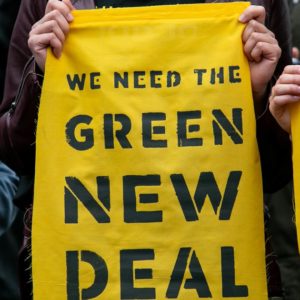Democratic presidential candidates want the American people to know that they are taking the threat of global climate change seriously. More seriously, in fact, than even former President Barack Obama or 2016 nominee Hillary Clinton.
As a recent Vox analysis notes, the Democratic party has rapidly pivoted away from the Obama administration’s much-touted “all-of-the-above energy strategy.” That meant simultaneously pursuing multiple goals: Energy independence, improved energy efficiency, expanded use of safer and cleaner carbon sources like natural gas, and investing in renewable energy for the future.
Not anymore. Gone are the days of Hillary Clinton’s moderate campaign promises of more “safe and responsible fossil fuel production,” replaced by 2020 candidates embracing her extreme anti-carbon rhetoric of “putting a lot of coal miners and coal companies out of business.”
For example, the Democrats’ 2020 front-runner, former Vice President Joe Biden, is considered a moderate. And yet he calls his comprehensive 22-page climate policy a “Plan for a Green Energy Revolution and Environmental Justice.” It certainly doesn’t sound moderate. Perhaps because it’s not.
Biden’s plan would cost a total of $6.7 trillion, and demand “net zero greenhouse gas emissions” by 2050. Spending more than the entire current federal budget and shutting down the carbon energy sector is hardly “moderate.”
Unless you compare Biden’s approach to his fellow 2020 candidates.
Vermont Senator (and self-described socialist) Bernie Sanders wants to wage war against the fossil fuel industry, declaring it’s “destroying the planet.” Sanders’ plan would ban nuclear energy, offshore drilling, fracking, and any extracting of coal, natural gas, oil and tar sands on federally owned lands. Like Washington Gov. Jay Inslee, Sanders has suggested treating carbon energy companies like criminals and potentially prosecuting them for doing business.
“We’ve got to ask ourselves a simple question: What do you do with an industry that knowingly, for billions of dollars in short-term profits, is destroying this planet?” Sanders during the July Democratic presidential debate. “I say that is criminal activity that cannot be allowed to continue.”
Inslee has based his entire presidential campaign on the climate issue and, not surprisingly, he’s pushing a plan even left-leaning Vox describes as “radical.” Inslee wants to spend $9 trillion federal tax dollars over 10 years, ban any new natural gas pipelines, revoke those already permitted and eventually end all fossil fuel production entirely. That last part is a challenge given that, according to the 2019 U.S. Energy and Employment Report, fossil fuels overwhelmingly provide the energy Americans use to heat their homes, power their businesses and drive their cars.
And if $9 trillion pricetags sound high, many analysts believe that, as is so often the case with government programs, the real costs will likely be far higher.
Setting aside pricey social programs included in the Democrats’ energy policies — Sen. Elizabeth Warren’s includes a federal jobs guarantee, for example — even the friendliest analysis pegs the cost of switching the U.S. economy entirely to green energy at $18 – $20 trillion. And that’s just a start.
More expensive renewables will have an ongoing impact on household budgets across America. A new study from the Heartland Institute estimates that conservatively, the Green New Deal would add a permanent recurring cost of $37,454 to the average New Hampshire household every single year.
That estimate figures in additional electricity costs, shipping expenses, the expense of green vehicles, and building retrofits, but still cover the full cost, since the Green New Deal and other Democratic plans like it amount to “an overwhelmingly expensive proposal reliant on technologies that have not yet been invented” according to the study’s authors.
Among other things, the estimate cannot calculate the impact of wholesale changes in America’s farming, construction and industrial equipment, as well as the elimination of air cargo, on which rely not only mail and package delivery, but also the availability of fresh produce in much of the country.
And then there are the 10 million Americans currently working in the oil and gas sector, jobs that by definition would be phased out under most of the Democrats’ proposals. Yes, some would be replaced by jobs in the green energy sector, but many of those jobs will be subsidized by federal tax dollars and government policy, not market demand.
Polling shows that Americans care about the environment and are looking for serious proposals to address climate issues. At the same time, polls show Americans don’t want to put their fellow citizens out of work, and they are also unwilling to pay significantly more in their monthly utility bills in the war on climate change.
Pushing for all these energy policies simultaneously may be pushing swing voters away from the next Democratic nominee for president.

